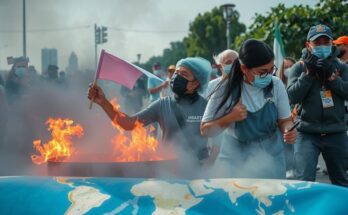Typhoon Toraji has struck northeastern Aurora in the Philippines, prompting evacuation orders in 2,500 villages due to the risk of flash floods and landslides. President Ferdinand Marcos Jr. has focused on recovery efforts following previous storms. The military has been deployed to assist in disaster response as the country faces its 14th severe weather event this year.
Typhoon Toraji recently impacted northeastern Aurora province in the Philippines, with its powerful winds reaching sustained speeds of 130 kilometers per hour and gusts up to 180 kilometers per hour. President Ferdinand Marcos Jr. prioritized recovery efforts after evaluating damage from previous storms and recently distributing food aid to affected residents in Cagayan and Ilocos provinces. As the storm is expected to traverse the mountainous areas of Luzon before heading towards the South China Sea, an extensive evacuation has been ordered for 2,500 villages at high risk of flooding and landslides.
In light of the imminent threat posed by Typhoon Toraji, Interior Secretary Jonvic Remulla emphasized the urgency of evacuation, stating that while some individuals may wish to remain, their safety must take precedence. The Philippine military mobilized disaster-response forces in vulnerable regions, pausing regular operations to focus on disaster management. In addition, schools, ferry services, and domestic flights have been suspended in areas projected to endure the typhoon’s impacts, marking the 14th significant weather disturbance in the archipelago this year.
The Philippines has been overwhelmed by recent natural disasters, with the last two typhoons and a tropical storm collectively causing over 160 fatalities, displacing more than 9 million individuals, and resulting in substantial destruction to homes and agriculture. Restricted by extensive rainfall, the government has accepted assistance from neighboring Southeast Asian nations, notably Singapore, and the United States, to expedite the delivery of vital supplies to severely affected regions.
The Philippines is situated in an area prone to tropical storms and typhoons, largely due to its geographic location in the Pacific Ocean. The country experiences numerous weather disturbances each year, often leading to devastating consequences such as flooding, landslides, and significant property damage. The recent cycles of storms have caused a humanitarian crisis, with millions of people displaced and requiring aid, highlighting the importance of disaster preparedness and international aid in mitigating impacts from natural disasters.
In summary, Typhoon Toraji has reiterated the vulnerability of the Philippines to severe weather events, prompting urgent evacuation efforts and military mobilization for disaster response. The ongoing humanitarian challenges stemming from recent storms have required both national and international intervention to support recovery and restoration efforts. As the nation continues to grapple with the consequences of these storms, there remains a critical need for effective disaster management strategies and collaborative aid initiatives.
Original Source: www.mid-day.com




